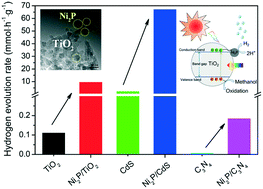General applicability of nanocrystalline Ni2P as a noble-metal-free cocatalyst to boost photocatalytic hydrogen generation†
Abstract
To replace the role of noble-metal cocatalysts (e.g. Pt) in photocatalytic hydrogen generation, low-cost alternatives with earth-abundant elements should not only possess high catalytic activities, but also have general applicability. Herein, nanocrystalline Ni2P cocatalysts are used to modify CdS, TiO2, and C3N4 host photocatalysts. It is observed that the Ni2P cocatalyst boosts hydrogen generation over all the host photocatalysts, which demonstrates its good catalytic property and general applicability. To investigate its action mechanism, nanocrystalline Ni2P was successfully integrated with TiO2 nanorods (TiNR) for the first time. The optimized Ni2P/TiNR sample exhibits an 85 times higher activity compared to single TiNR, and its apparent quantum efficiency was calculated to be 11.6% at 360 nm. Among the varied nickel-based semiconductor cocatalysts, Ni2P is also proven to be the best cocatalyst. Photoluminescence and electrochemical results reveal that the Ni2P cocatalyst promotes the charge transfer both in the photocatalyst and at the photocatalyst/solution interface, as well as accelerates the surface reaction. The enhanced charge transfer efficiency and improved surface reaction rate finally result in a dramatically improved performance. It is believed that the present work can provide basic principles for the development of noble-metal-free cocatalysts with high catalytic activity and general applicability.


 Please wait while we load your content...
Please wait while we load your content...